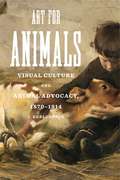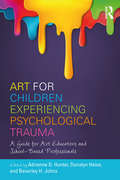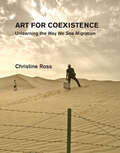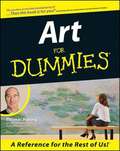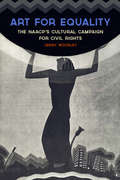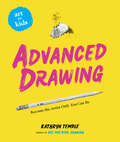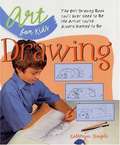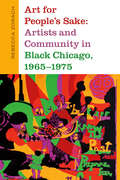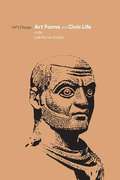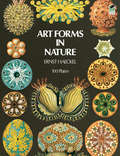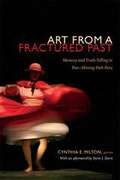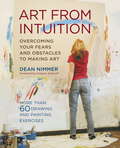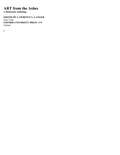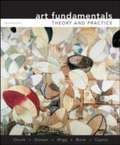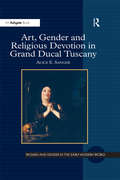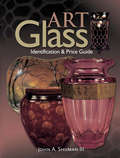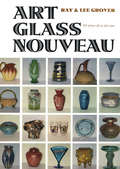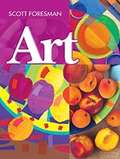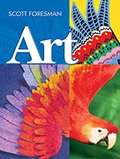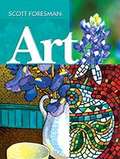- Table View
- List View
Art for Animals: Visual Culture and Animal Advocacy, 1870–1914 (Animalibus)
by J. Keri CroninAnimal rights activists today regularly use visual imagery in their efforts to shape the public’s understanding of what it means to be “kind,” “cruel,” and “inhumane” toward animals. Art for Animals explores the early history of this form of advocacy through the images and the people who harnessed their power.Following in the footsteps of earlier-formed organizations like the RSPCA and ASPCA, animal advocacy groups such as the Victoria Street Society for the Protection of Animals from Vivisection made significant use of visual art in literature and campaign materials. But, enabled by new and improved technologies and techniques, they took the imagery much further than their predecessors did, turning toward vivid, pointed, and at times graphic depictions of human-animal interactions. Keri Cronin explains why the activist community embraced this approach, details how the use of such tools played a critical role in educational and reform movements in the United States, Canada, and England, and traces their impact in public and private spaces. Far from being peripheral illustrations of points articulated in written texts or argued in impassioned speeches, these photographs, prints, paintings, exhibitions, “magic lantern” slides, and films were key components of animal advocacy at the time, both educating the general public and creating a sense of shared identity among the reformers.Uniquely focused on imagery from the early days of the animal rights movement and filled with striking visuals, Art for Animals sheds new light on the history and development of modern animal advocacy.
Art for Children Experiencing Psychological Trauma: A Guide for Art Educators and School-Based Professionals
by Adrienne D. Hunter Donalyn Heise Beverley H. JohnsArt for Children Experiencing Psychological Trauma aims to increase understanding of art’s potential to enhance learning for children living in crisis. In this ground-breaking resource, the first of its kind to focus specifically on the connection between art education and psychological trauma in youth populations, readers can find resources and practical strategies for both teachers and other school-based professionals. Also included are successful models of art education for diverse populations, with specific attention to youth who face emotional, mental, behavioral, and physical challenges, as well a framework for meaningful visual arts education for at-risk/in-crisis populations.
Art for Coexistence: Unlearning the Way We See Migration
by Christine RossAn exploration of how contemporary art reframes and humanizes migration, calling for coexistence—the recognition of the interdependence of beings.In Art for Coexistence, art historian Christine Ross examines contemporary art&’s response to migration, showing that art invites us to abandon our preconceptions about the current &“crisis&”—to unlearn them—and to see migration more critically, more disobediently. We (viewers in Europe and North America) must come to see migration in terms of coexistence: the interdependence of beings. The artworks explored by Ross reveal, contest, rethink, delink, and relink more reciprocally the interdependencies shaping migration today—connecting citizens-on-the-move from some of the poorest countries and acknowledged citizens of some of the wealthiest countries and democracies worldwide. These installations, videos, virtual reality works, webcasts, sculptures, graffiti, paintings, photographs, and a rescue boat, by artists including Banksy, Ai Weiwei, Alejandro González Iñárritu, Laura Waddington, Tania Bruguera, and others, demonstrate art&’s power to mediate experiences of migration. Ross argues that art invents a set of interconnected calls for more mutual forms of coexistence: to historicize, to become responsible, to empathize, and to story-tell. Art history, Ross tells us, must discard the legacy of imperialist museology—which dissocializes, dehistoricizes, and depoliticizes art. It must reinvent itself, engaging with political philosophy, postcolonial, decolonial, Black, and Indigenous studies, and critical refugee and migrant studies.
Art For Dummies
by Thomas Hoving Andrew WyethIf you've always wanted to find out more about art but felt intimidated by the overeducated art world, then you've found the answer. Art For Dummies is the book that will have you and everyone you know clamoring outside the doors of your local museum. Thomas Hoving, former director of New York's Metropolitan Museum of Art, is credited with revolutionizing the Met, doubling its size during his tenure, and bringing art to the masses. Let him bring art to you as well. In Art For Dummies, Thomas Hoving provides a how-to guide to the art world. First, he guides you through an introduction to art appreciation, pointing out the details that you've always noticed but have never been able to explain. Next, Hoving takes you on a ride through art history. (Have you ever regretted not taking those art history classes in school With Art For Dummies, you'll feel all caught up and ready to spar with the local intellectuals. ) Hoving even includes a guide to the world?s top art cities and centers, a listing that can help you prepare for your next artistic voyage. With this guide, you can discover where to go in order to see the greatest works of art, and you can also find out about hidden treasures in nearby art museums. You also get a great start for seeking out art with Hoving's lists of the greatest works of Western civilization, the most interesting artists, and the contemporary artists to watch. Don't wait another day to introduce yourself to the art world!
Art for Equality: The NAACP's Cultural Campaign for Civil Rights (Civil Rights and the Struggle for Black Equality in the Twentieth Century)
by Jenny WoodleyA study of the NAACP’s activism in the cultural realm through creative projects from 1910 to the 1960s.The National Association for the Advancement of Colored People (NAACP) is the nation’s oldest civil rights organization, having dedicated itself to the fight for racial equality since 1909. While the group helped achieve substantial victories in the courtroom, the struggle for civil rights extended beyond gaining political support. It also required changing social attitudes. The NAACP thus worked to alter existing prejudices through the production of art that countered racist depictions of African Americans, focusing its efforts not only on changing the attitudes of the White middle class but also on encouraging racial pride and a sense of identity in the Black community.Art for Equality explores an important and little-studied side of the NAACP’s activism in the cultural realm. In openly supporting African American artists, writers, and musicians in their creative endeavors, the organization aimed to change the way the public viewed the Black community. By overcoming stereotypes and the belief of the majority that African Americans were physically, intellectually, and morally inferior to Whites, the NAACP believed it could begin to defeat racism.Illuminating important protests, from the fight against the 1915 film The Birth of a Nation to the production of anti-lynching art during the Harlem Renaissance, this insightful volume examines the successes and failures of the NAACP’s cultural campaign from 1910 to the 1960s. Exploring the roles of gender and class in shaping the association's patronage of the arts, Art for Equality offers an in-depth analysis of the social and cultural climate during a time of radical change in America.Praise for Art for Equality“A well-conceived and well-executed study that will add significantly to the historiography of the NAACP, the long civil rights movement, and African American history.” —John Kirk, George W. Donaghey Professor and Chair of the History Department at the University of Arkansas at Little Rock“In this insightful book, Woodley writes with great verve and confidence. As a result, Art for Equality will attract readers in a variety of fields from African American history to art history to American political history.” —Matthew Pratt Guterl, Brown University“A necessary contribution to African American social and cultural histories.” —Journal of Southern History
Art for Kids: Become the Artist Only You Can Be (Art for Kids)
by Kathryn Temple&“This is a gold mine of information for any kid that doodles.&”—Library Media Connection This companion volume to Art for Kids: Drawing builds on skills taught in the first book, focusing on the integrating and big picture skills of drawing and the creative process. These include style, composition, content selection, sources of inspiration, quality of line (loose and gestural vs. clean and tight), as well as grounding and contextualizing subjects. Filled with clear instructions, easy-to-use techniques, and a wealth of encouragement, get ready to make great original drawings. You&’ll be amazed by the art they can create!
Art for Kids Drawing
by Kathryn TempleWith the help of lots of exercises, budding artists will learn the basic elements of shapes (lines, dots, circles) and see how to combine them to make familiar forms. They'll find out how to produce the illusion of volume with shading techniques; create perspective; accurately recreate landscapes, people, animals, and nature; develop interesting compositions; and more.
Art for People's Sake: Artists and Community in Black Chicago, 1965-1975
by Rebecca ZorachIn the 1960s and early 1970s, Chicago witnessed a remarkable flourishing of visual arts associated with the Black Arts Movement. From the painting of murals as a way to reclaim public space and the establishment of independent community art centers to the work of the AFRICOBRA collective and Black filmmakers, artists on Chicago's South and West Sides built a vision of art as service to the people. In Art for People's Sake Rebecca Zorach traces the little-told story of the visual arts of the Black Arts Movement in Chicago, showing how artistic innovations responded to decades of racist urban planning that left Black neighborhoods sites of economic depression, infrastructural decay, and violence. Working with community leaders, children, activists, gang members, and everyday people, artists developed a way of using art to help empower and represent themselves. Showcasing the depth and sophistication of the visual arts in Chicago at this time, Zorach demonstrates the crucial role of aesthetics and artistic practice in the mobilization of Black radical politics during the Black Power era.
Art for the Fun of It: A Guide for Teaching Young Children
by Peggy D. JenkinsThe book is directed toward those involved with children in the 3 through 8 age group, although there is no upper age limit for the use of most of these materials. The reader will gain a good foundation in the philosophy of art as it pertains to the child of this age group and will be able to share more understandingly the child's joy in artistic expression.
The Art Forger
by B. A. Shapiro[from the back cover] "On March 18, 1990, thirteen works of art worth today over $500 million were stolen from Boston's Isabella Stewart Gardner Museum. The crime remains unsolved. Claire Rothj a struggling young artist, is about to discover that there's more to this art heist than meets the eye. Striking a Faustian bargain with a powerful gallery owner, Claire agrees to forge a painting in exchange for a one-woman show. But her suspicions about the painting lead Claire to nineteenth-century secrets ... which may be the only evidence that can now save her life.""
Art Forms and Civic Life in the Late Roman Empire
by Hans Peter L'OrangeIn this study, originally published in Norway as Fra Principat Til Dominat, Professor L'Orange sets down the essence of his thought on the crucial period of transition from decentralization to standardization in civic and cultural life-a period not unlike our own.
Art Forms in Nature
by Ernst HaeckelErnst Heinrich Haeckel (1834-1919) was renowned as one of the foremost early exponents of Darwinism. His work was credited with having caused the acceptance of Darwinism in Europe, and his popular studies - preaching the continuity of all life, organic and inorganic, from prehistoric time to the present - converted tens of thousands of readers all over the world. Today, although no one is greatly interested in Haeckel the biologist-philosopher, his work is increasingly prized for something he himself would probably have considered secondary. These are the remarkable plates with which his work was illustrated, particularly his famous Kunstformen. The Kunstformen contains 100 beautiful lithographic plates which show a multitude of unusual life forms: Radiolaria, Foraminifera, and other forms of microscopic life; jellyfishes, starfishes, calcareous sponges, star corals, barnacles, and other sea life; mosses, lichens, red algae, ferns, fungi, orchids, and other plants; and turtles, moths, spiders, bats, frogs, lizards, hummingbirds, and antelope. With many drawings on each plate, each carefully drawn from nature, the subtle details of nature's art forms are easily compared and appreciated. In addition to being marvelous renderings, these plates have long been noted for the peculiar emotional appeal that they have for most viewers, a premonition of surrealism with exotic organic life forms stretching back to their roots in the inorganic, and individual details drawn with awareness of subtle evolutionary changes and millennia-long developments. Artists, illustrators, and others will find them still powerful as one of the landmarks of applied art.
Art from a Fractured Past: Memory and Truth Telling in Post–Shining Path Peru
by Cynthia E. MiltonPeru's Truth and Reconciliation Commission not only documented the political violence of the 1980s and 1990s but also gave Peruvians a unique opportunity to examine the causes and nature of that violence. In Art from a Fractured Past, scholars and artists expand on the commission's work, arguing for broadening the definition of the testimonial to include various forms of artistic production as documentary evidence. Their innovative focus on representation offers new and compelling perspectives on how Peruvians experienced those years and how they have attempted to come to terms with the memories and legacies of violence. Their findings about Peru offer insight into questions of art, memory, and truth that resonate throughout Latin America in the wake of "dirty wars" of the last half century. Exploring diverse works of art, including memorials, drawings, theater, film, songs, painted wooden retablos (three-dimensional boxes), and fiction, including an acclaimed graphic novel, the contributors show that art, not constrained by literal truth, can generate new opportunities for empathetic understanding and solidarity.Contributors. Ricardo Caro Cárdenas, Jesús Cossio, Ponciano del Pino, Cynthia M. Garza, Edilberto Jímenez Quispe, Cynthia E. Milton, Jonathan Ritter, Luis Rossell, Steve J. Stern, María Eugenia Ulfe, Víctor Vich, Alfredo Villar
Art From Intuition
by Dean NimmerPractical self-help for artists who want to free their creativity. Art from Intuition offers artists everywhere a unique system for freeing their own creative intuition, the sixth sense that directs an artist's drive and work. By letting go of the self-criticism, doubt, and insecurity that discourage artmaking, artists will be able to soar to new heights of creativity. More than 60 practical exercises take the reader from the most basic intuitive art to more sophisticated techniques. Each exercise, supported by step-by-step instructions, is accessible to artists at every level, and the exercises can be done in any order. After each chapter, readers are encouraged to follow up by evaluating their drawings or paintings to see how they reflect their own personal goals. Works of art by students and contemporary artists exemplify how exciting and how productive a freer, more intuitive approach to making art can be.From the Trade Paperback edition.
Art From The Sacred To The Profane: East
by Frithjof SchuonThis edition of renowned philosopher Frithjof Schuon&’s writings on the subject of art, selected and edited by his wife Catherine Schuon, contains over 270 photographs-200 color and 70 black and white. Keith Critchlow writes, &“This beautiful book … has the broadest coverage of any of the books on art that this writer has seen in forty years of teaching art and architecture.&” Frithjof Schuon, the foremost representative of the traditionalist school of thought, presents the universal principles and criteria with which to discern sacred from profane art, and traditional from merely &“religious&” art. He then deals with the spiritual significance of the artistic productions of Christianity, Islam, Hinduism, Buddhism, and the Far-Eastern world. Also covered are the subjects of beauty and the sense of the sacred, the crafts, poetry, music, dance, dress, and ambience.
Art From the Ashes: A Holocaust Anthology
by Lawrence L. LangerArt from the Ashes provides the most far-reaching collection of art, drama, poetry, and prose about the Holocaust ever presented in a single volume. <p><p>Through the works of men and women, Jews and non-Jews, this anthology offers a vision of the human reality of the catastrophe. Essays by familiar writers like Primo Levi and Elie Wiesel accompany lesser-known efforts by Yankiel Wiernik and Frantisek Kraus; stories by Tadeusz Borowski and Ida Fink join fiction by neglected authors such as Isaiah Spiegel and Adolf Rudnicki; and extensive selections have been chosen from the works of six poets--the renowned Paul Celan, Nelly Sachs, and Abraham Sutzkever among them. <p><p>Each selection (except for self-contained excerpts from ghetto journals and diaries) appears here in its complete form. Langer also includes in their entirety a novel by Aharon Appelfeld, a novella by Pierre Gascar, and Joshua Sobol's controversial drama Ghetto. In addition, this volume features a visual essay in the form of reproductions of twenty works of art created in the Terezin concentration camp.
Art from Trash (Fountas & Pinnell Classroom, Guided Reading Grade 1)
by Danielle BerkowNIMAC-sourced textbook
Art Fundamentals: Theory and Practice (11th Edition)
by Otto Ocvirk Robert Stinson David L. Cayton Philip Wigg Robert BoneThe original text that set the standard for introduction to art courses across the country,Art Fundamentals has guided generations of students through the essential elements of art as well as the rich and varied history of their uses. This eleventh edition has been carefully revised to expand and clarify concepts throughout the text, while adding new material on developing ideas, critical thinking, and time and motion.
Art, Gender and Religious Devotion in Grand Ducal Tuscany (Women and Gender in the Early Modern World)
by Alice E. SangerArt, Gender and Religious Devotion in Grand Ducal Tuscany focuses on the intersection of the visual and the sacred at the Medici court of the later sixteenth to early seventeenth centuries in relation to issues of gender. Through a series of case studies carefully chosen to highlight key roles and key interventions of Medici women, this book embraces the diversity of their activities, from their public appearances at the centre of processionals such as the bridal entrata, to the commissioning and collecting of art objects and the overseeing of architectural projects, to an array of other activities to which these women applied themselves with particular force and vigour: regular and special devotions, visits to churches and convents, pilgrimages and relic collecting. Positing Medici women’s patronage as a network of devotional, entrepreneurial and cultural activities that depended on seeing and being seen, Alice E. Sanger examines the specific religious context in which the Medici grand duchesses operated, arguing that these patrons’ cultural interests responded not only to aesthetic concerns and the demands of personal faith, but also to dynastic interests, issues of leadership and authority, and the needs of Catholic reform. By examining the religious dimensions of the grand duchesses' art patronage and collecting activities alongside their visually resonant devotional and public acts, Sanger adds a new dimension to the current scholarship on Medici women’s patronage.
Art Glass Identification & Price Guide
by John Shuman IIIDaring designers such as Louis Comfort Tiffany and Reneacute Lalique are remembered for their intricate pattern creations with glass that pushed the evolution of design. These entrancingly beautiful masterpieces of yesterday are commanding high prices in today's antiques and collectibles marketplace. Author John Shuman Ill gives art glass collectors the helpful advice they need - from bidding techniques at auctions and detecting fakes and frauds, to protecting valuable. With the aid of this identification and price guide they'll obtain a collection they can be proud to display. Valuable information and current market prices are included for Baccarat, Custard Glass, Durand Art Glass, Fairy Lamps, Kimball Glass, Lalique, Loetz, Tiffany, and much more. Readers will confidently identify collectible pieces with more than 300 color images, illustrations, and vintage advertisements. They'll peruse original advertisements from sale catalogues and marvel at the progression of some of the most highly sought after art glass pieces from popular manufactures.
Art Glass Nouveau
by Ray Grover Lee GroverArt Glass Nouveau was originally published by Tuttle Publishing in print form in 1967.NEVER BEFORE has there ever been such a rapid and widespread surge of interest in any field of collecting as there now is in discovering the magnificent beauty of colored art glass, the many unique pieces that were produced extensivelyin the United States, Great Britain, and other European countries during the late 19th and early 20th centuries, when this fine art was at its height. And never before has there been such an informative, useful, and thoroughly illustrated book on this subject as this definitive work by Ray and Lee Grover.All of the illustrations are in full color. The book contains 424 plates, 50 of which are full page. The complete description of each piece indicates its size, the type of glass used, its identification marks, the names of the designer and/or producer, when known, and its present owner. While every significant type of art glass produced during this period is covered in the succinct text, the exciting galaxy of 424 plates, interspersed throughout the book, were selectednot only because of their rare beauty and authenticity, but also to show representative pieces, similar to those that are still obtainable. Most important of all in identifying a piece and determining its value, according to the authors, are its color, its shape, and the texture of its surface, to which they constantly give particular attention.
